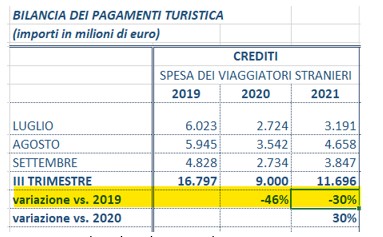All the damages of the pandemic to tourism in Italy (and not only in Italy)

Between 2020 and 2021, tourism in Italy has lost a lot. But in Spain and Greece it was worse. The in-depth study by Giuseppe Liturri
Since yesterday, the picture of the tsunami that has overwhelmed the tourism sector in Italy (and beyond) due to the containment measures of the pandemic between 2020 and 2021 is clearer.
The data updated in September were published by the Bank of Italy and the third quarter, traditionally characterized by the most consistent tourist flows, was completed and the figures are dramatic. Especially in the light of the huge investments to encourage the resumption of travel, first of all the massive vaccination campaign and the so-called green pass, developed by the EU Commission precisely to allow holders an easy intra-community transit without undergoing quarantine periods.
We focus in particular on the expenditure of foreigners in Italy which stands at -30% compared to the same quarter of 2019, an inevitable touchstone for measuring the distance from normality, considering the disaster of 2020. In absolute numbers, we go down from 16.8 to 11.7 billion. The 30% increase recorded this year compared to the third quarter of 2020 is comforting but evidently does not fill the gap dug last year, when spending fell by 46% compared to 2019.

If we pass from the values to the number of travelers and overnight stays, the picture also tends to worsen and provides us with interesting food for thought. In fact, the decline in these aggregates, compared to 2019, is more marked than that of expenditure (-44% in the number of travelers and -35% in the number of overnight stays). Similarly, the rebound of 2021 compared to 2020 is less substantial than that of spending. With all the necessary precautions, considering the many variables involved that we are omitting, it would seem that the tourists we lost in 2021 compared to 2019 were those with relatively less spending power. Considering the rebound of 2021 compared to 2020, this phenomenon is further confirmed. In fact, the growth in spending is much higher than that of the number of travelers and therefore it is likely that those who had greater spending capacity returned to travel.

The Italian figure must necessarily be compared with the other two tourist “powers” of the Mediterranean: Spain and Greece. And it was much worse for them.
The Iberians in the third quarter of 2021 recorded foreign tourist spending of € 13.6 billion, still 48% less than the 26.2 billion in 2019 and increased by 2.5 times compared to the abyss of 5.3 billions touched in 2020. It should be emphasized that we are talking about two orders of different figures: 26 billion in receipts from the Spaniards were a much higher mass than the 16 billion from Italians. In their case, being larger resulted in greater exposure to losses. For Italy, smaller positions proved to be more easily defensible, while still showing large losses.
Greece , moving to lower levels of tourist spending by foreigners compared to Italian and Spanish ones, suffered the blow even more evidently, due to the greater concentration of flows in the summer months. 2020 closed at -76% compared to 2019 (18.1 billion against 4.3 billion) and the first two quarters of 2021 show a -78% compared to 2019.
Comparing these percentages to those of Italy (negative but clearly better), it is appropriate to say that "if Athens cries, Sparta does not laugh".
This is a machine translation from Italian language of a post published on Start Magazine at the URL https://www.startmag.it/economia/italia-settore-turismo-pandemia/ on Tue, 14 Dec 2021 07:02:21 +0000.
